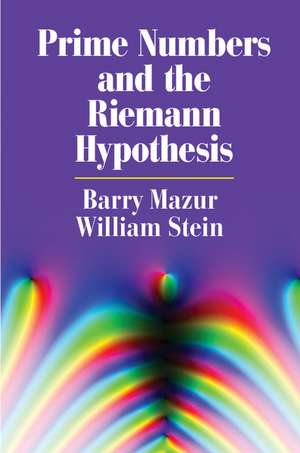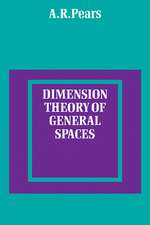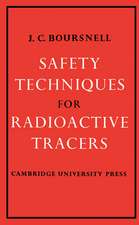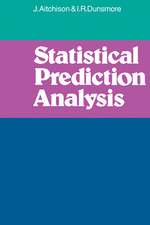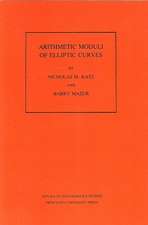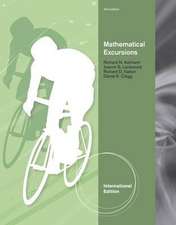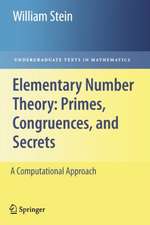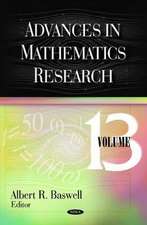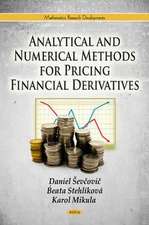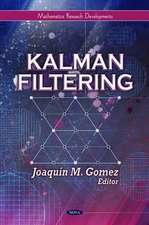Prime Numbers and the Riemann Hypothesis
Autor Barry Mazur, William Steinen Limba Engleză Hardback – 10 apr 2016
| Toate formatele și edițiile | Preț | Express |
|---|---|---|
| Paperback (1) | 175.91 lei 22-36 zile | +9.56 lei 6-12 zile |
| Cambridge University Press – 10 apr 2016 | 175.91 lei 22-36 zile | +9.56 lei 6-12 zile |
| Hardback (1) | 460.77 lei 43-57 zile | |
| Cambridge University Press – 10 apr 2016 | 460.77 lei 43-57 zile |
Preț: 460.77 lei
Nou
Puncte Express: 691
Preț estimativ în valută:
88.20€ • 95.83$ • 74.13£
88.20€ • 95.83$ • 74.13£
Carte tipărită la comandă
Livrare economică 21 aprilie-05 mai
Preluare comenzi: 021 569.72.76
Specificații
ISBN-13: 9781107101920
ISBN-10: 1107101921
Pagini: 156
Ilustrații: 110 b/w illus. 132 colour illus.
Dimensiuni: 154 x 239 x 13 mm
Greutate: 0.39 kg
Editura: Cambridge University Press
Colecția Cambridge University Press
Locul publicării:New York, United States
ISBN-10: 1107101921
Pagini: 156
Ilustrații: 110 b/w illus. 132 colour illus.
Dimensiuni: 154 x 239 x 13 mm
Greutate: 0.39 kg
Editura: Cambridge University Press
Colecția Cambridge University Press
Locul publicării:New York, United States
Cuprins
1. Thoughts about numbers; 2. What are prime numbers?; 3. 'Named' prime numbers; 4. Sieves; 5. Questions about primes; 6. Further questions about primes; 7. How many primes are there?; 8. Prime numbers viewed from a distance; 9. Pure and applied mathematics; 10. A probabilistic 'first' guess; 11. What is a 'good approximation'?; 12. Square root error and random walks; 13. What is Riemann's hypothesis?; 14. The mystery moves to the error term; 15. Césaro smoothing; 16. A view of Li(X) - π(X); 17. The prime number theorem; 18. The staircase of primes; 19. Tinkering with the staircase of primes; 20. Computer music files and prime numbers; 21. The word 'spectrum'; 22. Spectra and trigonometric sums; 23. The spectrum and the staircase of primes; 24. To our readers of part I; 25. Slopes and graphs that have no slopes; 26. Distributions; 27. Fourier transforms: second visit; 28. Fourier transform of delta; 29. Trigonometric series; 30. A sneak preview; 31. On losing no information; 32. Going from the primes to the Riemann spectrum; 33. How many θi's are there?; 34. Further questions about the Riemann spectrum; 35. Going from the Riemann spectrum to the primes; 36. Building π(X) knowing the spectrum; 37. As Riemann envisioned it; 38. Companions to the zeta function.
Recenzii
'This is an extraordinary book, really one of a kind. Written by two supreme experts, but aimed at the level of an undergraduate or curious amateur, it emphasizes the really powerful ideas, with the bare minimum of math notation and the maximum number of elegant and suggestive visuals. The authors explain why this legendary problem is so beautiful, why it is difficult, and why you should care.' Will Hearst, Hearst Corporation
'This book is a soaring ride, starting from the simplest ideas and ending with one of the deepest unsolved problems of mathematics. Unlike in many popular math books puffed up with anecdotal material, the authors here treat the reader as seriously interested in prime numbers and build up the real math in four stages with compelling graphical demonstrations revealing in deeper and deeper ways the hidden music of the primes. If you have ever wondered why so many mathematicians are obsessed with primes, here's the real deal.' David Mumford, Brown University, Rhode Island
'This is a delightful little book, not quite like anything else that I am aware of … a splendid piece of work, informative and valuable. Undergraduate mathematics majors, and the faculty who teach them, should derive considerable benefit from looking at it.' Mark Hunacek, MAA Reviews
'This book is divided into four parts, and succeeds beautifully in giving both an overview for the general audience and a sense of the details needed to understand how quickly the number of primes grows. This is accomplished through a very clear exposition and numerous illuminating pictures.' Steven Joel Miller, MathSciNet
'Where popularizers of mathematics usually succumb either to a journalist's penchant for 'man bites dog' irony and spectacle or a schoolteacher's iron will to simplify away the terror, one might call the distinctive approach here 'take a lay reader to work'. Computers now provide mathematicians a laboratory, and the authors exploit this modern power to exhibit graphics, making the key equivalence a luminous phenomenon of experimental mathematics … for its clarity and the importance of its topic, this book deserves the same classic status as A Brief History of Time (CH, Jul'88). Summing Up: Essential. All readers.' D. V. Feldman, CHOICE
'Prime Numbers and the Riemann Hypothesis is an agile, unusual book written over a decade, one week per year; it can be considered a sort of collaborative work, in that each version was put online with the purpose of getting feedback.' Massimo Nespolo, Acta Crystallographica Section A: Foundations and Advances
'… a great gift for a curious student. Using the graphical methods found in calculus reform texts, this beautiful little book allows a patient reader with a good grasp of first-year calculus to explore the most famous unsolved problem in mathematics, the so-called Riemann Hypothesis, and to understand why it points to as yet undiscovered regularities in the distribution of prime numbers.' Donal O'Shea, The Herald Tribune
'The book under review succeeds handsomely in making the case for the Riemann Hypothesis to a wide audience … Beginning with the definition of prime numbers, the authors weave their way through concrete and picturesque presentations of elementary techniques and descriptions of unsolved problems connected with the primes. They provide many insightful footnotes, concrete and illuminating figures, pointers to arXiv pages for added information, and a rich set of endnotes that contain further descriptions and details with varying levels of sophistication. After 23 short sections (a few pages each) they have arrived at a formulation of the Riemann Hypothesis in terms of counting primes up to a given size. By this point in their masterful and compelling presentation, the Hypothesis appears to be completely natural and inevitable … I have no doubt that many newcomers to the subject who have read to the end of the book will be eager to learn more and will be drawn into this fertile playground.' Peter Sarnak, Bulletin of the AMS
'I really recommend this book if you want to get a feeling for the Riemann hypothesis without sinking into technicalities.' John Baez, The n-Category Café (http://golem.ph.utexas.edu/category)
'This book is a soaring ride, starting from the simplest ideas and ending with one of the deepest unsolved problems of mathematics. Unlike in many popular math books puffed up with anecdotal material, the authors here treat the reader as seriously interested in prime numbers and build up the real math in four stages with compelling graphical demonstrations revealing in deeper and deeper ways the hidden music of the primes. If you have ever wondered why so many mathematicians are obsessed with primes, here's the real deal.' David Mumford, Brown University, Rhode Island
'This is a delightful little book, not quite like anything else that I am aware of … a splendid piece of work, informative and valuable. Undergraduate mathematics majors, and the faculty who teach them, should derive considerable benefit from looking at it.' Mark Hunacek, MAA Reviews
'This book is divided into four parts, and succeeds beautifully in giving both an overview for the general audience and a sense of the details needed to understand how quickly the number of primes grows. This is accomplished through a very clear exposition and numerous illuminating pictures.' Steven Joel Miller, MathSciNet
'Where popularizers of mathematics usually succumb either to a journalist's penchant for 'man bites dog' irony and spectacle or a schoolteacher's iron will to simplify away the terror, one might call the distinctive approach here 'take a lay reader to work'. Computers now provide mathematicians a laboratory, and the authors exploit this modern power to exhibit graphics, making the key equivalence a luminous phenomenon of experimental mathematics … for its clarity and the importance of its topic, this book deserves the same classic status as A Brief History of Time (CH, Jul'88). Summing Up: Essential. All readers.' D. V. Feldman, CHOICE
'Prime Numbers and the Riemann Hypothesis is an agile, unusual book written over a decade, one week per year; it can be considered a sort of collaborative work, in that each version was put online with the purpose of getting feedback.' Massimo Nespolo, Acta Crystallographica Section A: Foundations and Advances
'… a great gift for a curious student. Using the graphical methods found in calculus reform texts, this beautiful little book allows a patient reader with a good grasp of first-year calculus to explore the most famous unsolved problem in mathematics, the so-called Riemann Hypothesis, and to understand why it points to as yet undiscovered regularities in the distribution of prime numbers.' Donal O'Shea, The Herald Tribune
'The book under review succeeds handsomely in making the case for the Riemann Hypothesis to a wide audience … Beginning with the definition of prime numbers, the authors weave their way through concrete and picturesque presentations of elementary techniques and descriptions of unsolved problems connected with the primes. They provide many insightful footnotes, concrete and illuminating figures, pointers to arXiv pages for added information, and a rich set of endnotes that contain further descriptions and details with varying levels of sophistication. After 23 short sections (a few pages each) they have arrived at a formulation of the Riemann Hypothesis in terms of counting primes up to a given size. By this point in their masterful and compelling presentation, the Hypothesis appears to be completely natural and inevitable … I have no doubt that many newcomers to the subject who have read to the end of the book will be eager to learn more and will be drawn into this fertile playground.' Peter Sarnak, Bulletin of the AMS
'I really recommend this book if you want to get a feeling for the Riemann hypothesis without sinking into technicalities.' John Baez, The n-Category Café (http://golem.ph.utexas.edu/category)
Notă biografică
Descriere
This book introduces prime numbers and explains the famous unsolved Riemann hypothesis.
